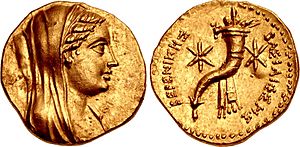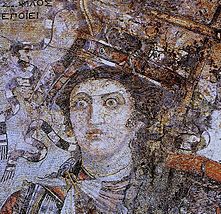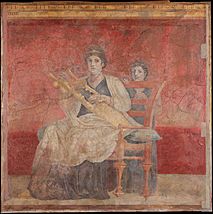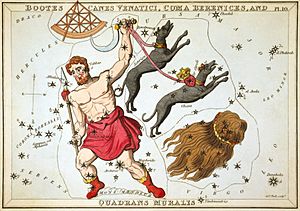Berenice II of Egypt facts for kids
Quick facts for kids Berenice II |
|||||
|---|---|---|---|---|---|
| Queen of Cyrenaica and Egypt | |||||
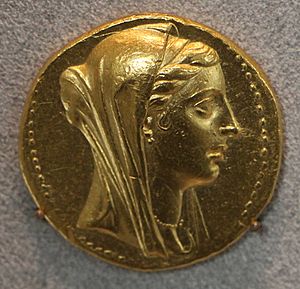
Octodracma of Berenice II
|
|||||
| Born | c. 267 – 266 BC | ||||
| Died | 221 BC | ||||
| Spouse | Demetrius the Fair Ptolemy III Euergetes |
||||
| Issue | Ptolemy IV Arsinoe III Alexander Magas of Egypt Berenice |
||||
|
|||||
| Dynasty | Ptolemaic | ||||
| Father | Magas of Cyrene | ||||
| Mother | Apama II | ||||
Berenice II Euergetis (born around 267 or 266 BC, died 221 BC) was a powerful queen in ancient times. Her name, Berenice Euergetes, means "Berenice the Benefactress." She ruled Cyrenaica (a region in modern-day Libya) from about 250 BC. Later, she became queen and co-ruler of Ptolemaic Egypt from 246 BC to 222 BC. She was married to Ptolemy III Euergetes, who was the third ruler of the Ptolemaic kingdom.
Berenice inherited the rule of Cyrene from her father, Magas, in 249 BC. After some struggles, she married her half-cousin Ptolemy III. This marriage helped bring Cyrenaica back into the large Ptolemaic empire. As queen of Egypt, Berenice was very involved in governing. She was even worshipped as a goddess alongside her husband. She is most famous for cutting off her hair as a special gift to the gods. This act led to a group of stars, a constellation, being named after her: Coma Berenices. Berenice was sadly killed by a powerful official named Sosibius in 221 BC, shortly after her son Ptolemy IV Philopator became king.
Contents
Life of Berenice II
Cyrenaica was a region that became part of the Ptolemaic kingdom around 323 BC. This happened shortly after the death of Alexander the Great. The first Ptolemaic ruler, Ptolemy I Soter, found it hard to control Cyrenaica. So, around 300 BC, he gave control of the region to Magas. Magas was the son of Ptolemy I's wife, Berenice I, from an earlier marriage.
After Ptolemy I died, Magas decided to rule Cyrenaica independently. He even fought against Ptolemy I's successor, Ptolemy II Philadelphus. Around 275 BC, Magas married Apama II. She came from the Seleucid dynasty, which was a rival kingdom to the Ptolemies. Berenice II was their only child.
In the late 250s BC, Ptolemy II tried again to make peace with Magas. They agreed that Berenice would marry her half-cousin, Ptolemy III Euergetes. He was the heir to the Egyptian throne.
A Brave Queen's Story
The ancient writer Gaius Julius Hyginus tells a story about Berenice. He claims that once, her father Magas and his soldiers were losing a battle. Berenice bravely got on a horse and gathered the remaining troops. She fought fiercely, defeating many enemies and making the rest retreat. It's not fully clear if this story is true, but it shows her strong spirit.
Becoming Queen of Cyrene
Around 250 BC, Magas died, and Berenice became the ruling queen of Cyrene. At this time, Berenice's mother, Apame, did not want her to marry Ptolemy III as planned. Instead, Apame invited a prince named Demetrius the Fair from the Antigonid dynasty to Cyrene to marry Berenice.
Demetrius took control of the city with Apame's help. However, Berenice soon had Demetrius removed from power. Apame was not harmed. Control of Cyrene was then given to a group of local leaders. This lasted until Berenice's actual wedding to Ptolemy III in 246 BC, after he became king of Egypt.
Queen of Egypt
Berenice married Ptolemy III in 246 BC. This marriage brought Cyrenaica back under Egyptian control. It stayed part of the Ptolemaic kingdom for many years.
Worshipped as a Goddess
Around 244 or 243 BC, Berenice and her husband were made part of the official state religion. They were worshipped as the Theoi Euergetai, meaning "Benefactor Gods." This was alongside Alexander the Great and earlier Ptolemaic rulers. Berenice was also worshipped as a goddess on her own, called Thea Euergetis ("Benefactor Goddess").
People often linked her with the goddesses Aphrodite and Isis. She was especially seen as a protector for sailors against shipwrecks. Many signs of her worship come from later times, but a cult honoring her existed during Ptolemy III's reign. This worship was similar to that of her mother-in-law, Arsinoe II. Arsinoe II was also linked to Aphrodite and Isis and seen as a protector from shipwrecks.
Berenice's Lock of Hair
Berenice's special connection to the gods is shown in the famous story of "Berenice's Lock." The story says that Berenice promised to cut off her long hair as a special gift to the gods. She made this promise if her husband, Ptolemy III, returned safely from a war.
She dedicated her hair and placed it in a temple in Alexandria. This temple was where Arsinoe II was worshipped as Aphrodite. But the next morning, the hair was gone! Conon of Samos, the court astronomer, said that the missing hair had become a new constellation in the sky. He claimed Aphrodite had placed it there to honor Berenice's sacrifice. This group of stars is still known today as Coma Berenices, which means 'Berenice's Lock' in Latin.
This story helped connect Berenice to the goddess Isis. Isis was known as a goddess of rebirth. The Ptolemaic court made sure this story was widely known. Poets like Callimachus wrote poems about it. The Roman poet Catullus later wrote his own version. This story became very popular and was even painted by many artists in later centuries.
Olympic Victories
Berenice was also a successful athlete. She entered a chariot team in the Nemean Games in 243 or 241 BC, and her team won! This victory was celebrated in another poem by Callimachus. The poem linked Berenice to Io, a figure from Greek mythology. According to Hyginus, Berenice also entered a team in the Olympic games at some point.
Death of Berenice II
Ptolemy III died in late 222 BC. His son, Ptolemy IV Philopator, became the new king. Berenice died soon after, in early 221 BC. The historian Polybius wrote that she was poisoned. This was part of a plan by the new king's chief minister, Sosibius, to remove other members of the royal family. Even after her death, Berenice continued to be honored as a goddess in the state religion.
Children of Berenice II
With Ptolemy III, Berenice had several children:
| Name | Image | Born | Died | Notes |
|---|---|---|---|---|
| Arsinoe III |  |
246/5 BC | 204 BC | She married her brother Ptolemy IV in 220 BC. |
| Ptolemy IV Philopator |  |
May/June 244 BC | July/August 204 BC | He was King of Egypt from 222 to 204 BC. |
| A son | July/August 243 BC | Perhaps 221 BC | His name is unknown, possibly 'Lysimachus'. He likely died in or before the political changes of 221 BC. | |
| Alexander | September/October 242 BC | Perhaps 221 BC | He also likely died in or before the political changes of 221 BC. | |
| Magas | November/December 241 BC | 221 BC | He was killed by order of Ptolemy IV. | |
| Berenice | January/February 239 BC | February/March 238 BC | She was made a goddess after her death in 238 BC, known as Berenice Anasse Parthenon. |
Legacy of Berenice II
The ancient city of Euesperides, which is now the city of Benghazi in Libya, was renamed Berenice in her honor. It kept this name until the Middle Ages.
The asteroid 653 Berenike, discovered in 1907, was also named after Queen Berenice.
See also
 In Spanish: Berenice II de Egipto para niños
In Spanish: Berenice II de Egipto para niños


